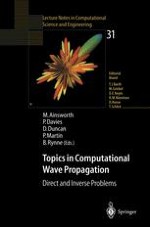2003 | OriginalPaper | Buchkapitel
Herglotz Wave Functions in Inverse Electromagnetic Scattering Theory
verfasst von : David Colton, Peter Monk
Erschienen in: Topics in Computational Wave Propagation
Verlag: Springer Berlin Heidelberg
Enthalten in: Professional Book Archive
Aktivieren Sie unsere intelligente Suche, um passende Fachinhalte oder Patente zu finden.
Wählen Sie Textabschnitte aus um mit Künstlicher Intelligenz passenden Patente zu finden. powered by
Markieren Sie Textabschnitte, um KI-gestützt weitere passende Inhalte zu finden. powered by
Ever since the invention of radar during the Second World War, scientists and engineers have strived not only to detect but also to identify unknown objects through the use of electromagnetic waves. Indeed, as pointed out in [19], “Target identification is the great unsolved problem. We detect almost everything; we identify nothing”. A significant step forward in the resolution of this problem occurred in the 1960's with the invention of synthetic aperture radar (SAR) and since that time numerous striking successes have been recorded in imaging by electromagnetic waves using SAR [1], [7]. However, as the demands of randar imaging have increased, the limitations of SAR have become increasingly apparent. These limitations arise from the fact that SAR is based on the “weak scattering” approximation and ignores polarisation effects. Indeed, such incorrect model assumptions have caused some scientists to ask “how (and if) he complications associated with radar based automatic target recognition can be surmounted” ([1], p. 5).
